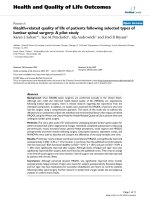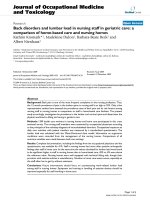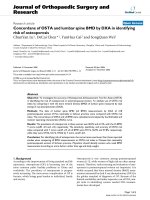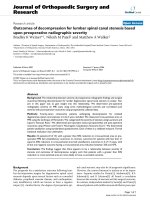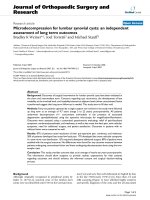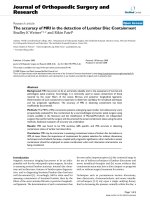Lumbar punture
Bạn đang xem bản rút gọn của tài liệu. Xem và tải ngay bản đầy đủ của tài liệu tại đây (290.77 KB, 20 trang )
Lumbar puncture
Lumbar puncture
Invasive
procedure:
diagnostic or therapeutic.
The subarachnoid space
4-13 ys: 65-150ml
Replenished: 4- 6 h
Routine LP (3- 5 ml): <1h
INDICATIONS
For Dx:
For Rx:
CNS infection
Idiopathic intracranial hypertension
(pseudotumor cerebri)
Subarachnoid hemorrhage (CT
scan normal)
Spinal cord imaging
Evaluation of various neurologic
conditions
Anesthesia
CONTRAINDICATIONS
Elevated ICP owing to a suspected mass lesion of the brain or
spinal cord.
Symptoms and signs of pending cerebral herniation in a child
with probable meningitis.
Critical illness.
Skin infection at the site of the LP
Thrombocytopenia.
COMPLICATIONS
Post dural puncture headache (PDPH):
Common (5-15%)
Frontal or occipital, 6 to 72 hours.
Nausea, vomiting, dizziness, tinnitus, neck stiffness, and
visual changes.
Lasts 2 to 15 days
COMPLICATIONS
Cerebral herniation:
Most serious complication, rare
Normal results on computed tomography: do not mean safe
to do a LP in a child with bacterial meningitis.
Infection: Meningitis, epidural abscess, or osteomyelitis
Cellulitis or soft tissue infection at the site of puncture
COMPLICATIONS
Epidermoid tumor: Rare, years after
Epidermoid tissue, transplanted into the spinal canal, without
a stylet, or poorly fitting
Spinal hematoma: Epidural, subdural, and subarachnoid
hemorrhage
Uncorrected bleeding disorders/ no apparent risk factors for
bleeding
Back pain + neurologic findings emergent evaluation
Evidence-based clinical
decision
INDICATIONS
LP in Febrile Seizure (FS)
Systematic Review and Meta-Analysis : MEDLINE, INIST,
and the COCHRANE Library databases: 14 studies
first “seizure and fever”: 5 studies (1996 patients); the
pooled prevalence of Bacterial Meningitis (BM) was 2.6%
(95% CI 0.9–5.1)
apparent simple FS: 7 studies (1869 patients) ; 0.2% (range 0
to 1%).
apparent complex FS: 2 studies (718 patients); 0.6% (95% CI
0.2–1.4)
CONCLUSIONS: The risk of BM presenting solely as an
apparent FS is very low, whatever age or features of seizure
(simple or complex). Routine LP in the absence of any other
signs and symptoms suggestive of BM: low utility in febrile,
young children presenting with a first seizure
From Pediatrics 2010;126:62–69
Retrospective cohort review: 526 patients, aged 6 to 60 months,
first complex FS. 340 (64%) had a LP
3 patients: acute BM, all with S pneumoniae (0.9%:[95% CI:
0.2–2.7]), ill appearing or meningeal signs and symptoms
CONCLUSIONS: Few patients who experienced a CFS had ABM
in the absence of other signs or symptoms
Unnecessary in most well-appearing children who have returned
to a normal baseline after FS
should be performed : ill appearing or meningeal signs and
symptoms
an option: child 6 to 12 months + deficient in Hib and S
pneumoniae immunizations or immunization status is
unknown.
an option: have been pretreated with antibiotics.
( From UPTODATE 2014; AAP, Clinical
Practice Guidelin - Febrile Seizures,
Pediatrics 2011)
Evidence-based clinical
decision
COMPLICATIONS
PDPH
The Cochrane Library 2013, Issue 7
RCTs: 23 trials (2477 participants)
PDPH: Risk for bed rest 26.4%; risk for mobilization 20.5%; risk
ratio (RR) 1.30; 95% confidence interval (CI) 1.09 to 1.55).
Two trials that assessed fluid supplementation did not find this
preventive measure to be useful in the prevention of PDPH
Routine bed rest after dural
puncture is not beneficial for the
prevention of PDPH onset. The role of
fluid supplementation in the prevention
of PDPH remains unclear.
CONCLUSION:
Randomized trial: 111 patients, 2-17 ys (24- hour bed
rest >< free mobility).
Patients of the bed-rest group encountered significantly
more head- or backaches (positional headache 15 vs 2%;
all headaches 39 vs 21%; backaches 42 vs 23%).
Prophylactic bed rest following lumbar
puncture in children and adolescents is
of no benefit and may actually be
disadvantageous.
Evidence-based clinical
decision
COMPLICATIONS
Cerebral Herniation
Retrospective review of case notes: 445children (>30ds)
admitted to hospital with bacterial meningitis.
Cerebral herniation was detected in 19(4,3%) of the 445
children: 14 (45%) of the 31 children who died; 17 children LP.
The first 12 hours after LP over six other 12 hour periods:
odds ratio 32.6 (95% confidence interval 8.5 to 117.3)
p
The results of cranial CT were normal in 36% (14 episodes of
herniation)
CONCLUSION-The temporal relation between lumbar
puncture and herniation strongly suggests that a lumbar
puncture may cause herniation in some patients, and
normal results on CT do not mean that it is safe to do a
lumbar puncture in a child with bacterial meningitis.
CONCLUSION
Invasive procedure.
Unnecessary in most well-appearing
children who have returned to a normal
baseline after FS
Routine bed rest after dural puncture is
not beneficial for the prevention of
PDPH onset.

